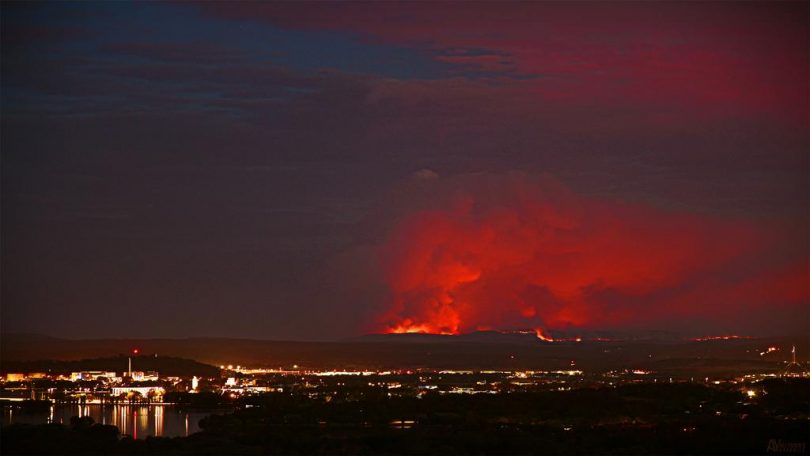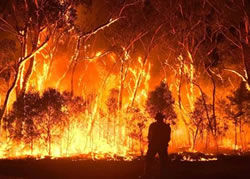
The North Black Range fire as seen from Canberra at the height of the Black Summer fires. Photo: AYMcreations.
In a finding that may turn received wisdom on its head, a landmark new study from the ANU and Curtin University has found that prescribed burning and logging may make Australian forests more flammable, not less.
The authors have issued a plea for better analysis of extreme-risk areas and deployment of rapid-response firefighting teams, controlling fires in remote areas rather than allowing them to burn out of control.
The research was conducted by the ANU’s Professor David Lindenmayer, a world expert in forest ecology, and Associate Professor Philip Zylstra, from Curtin University.
They found while prescribed burns can sometimes decrease flammability in the short term, the disruption caused to forest ecosystems by prescribed, or controlled, burning can create longer periods of additional flammability that may be more intense, particularly in remote areas.
And, the researchers say, the preference for large interventions in forest management is likely to be simplistic and grounded in a poor understanding of long-term natural dynamics.
“Very frequent burning close to homes or control lines could create defendable spaces, but large, remote and infrequent burns maintain the landscape at maximum fire risk because they undermine the natural controls that forests place on fire,” Associate Professor Zylstra said.

The ANU’s Professor David Lindenmayer co-authored the study on controlled burning. Photo: ANU Media.
The authors say there needs to be a greater connection between forestry and fire science to understand how fire-prevention strategies affect the natural environment, including work with scientists who understand how forest ecosystems operate over decades.
“We’ve understood for a long time now that logging can make bushfires worse, but it’s only in the last few years that evidence is showing that prescribed burning could be doing the same thing,” Professor Lindenmayer said.
The authors found that a diverse understory of plants calms bushfires in forests by slowing the wind beneath them. If disturbance kills those taller plants, replacements regrow from the ground and cumulatively add to the fuel load.
“Fire-sensitive species thrived for millions of years because so many forests naturally create these less-flammable environments,” Professor Lindenmayer said.
“We know that old forests tend to be cooler, more moist and more sheltered. By limiting disturbance, forests can reach an appropriate age where they can be better protected from the increased frequency and severity of Australian bushfires.”
The research includes a predictive framework for identifying areas where disturbance is likely to cause a surge in bushfire risk, enabling better-informed and targeted management strategies.
This focus on areas that are particularly high risk should also enable better and faster detection and responses, particularly in remote areas.
The authors say investment in rapid-response remote area firefighting equipment and specialists is urgently needed.
“We need to … embrace new technologies that allow us to detect fires and suppress them faster,” Professor Lindenmayer said, noting advances in drone technology and the application of artificial intelligence to detecting small fires and extinguishing them at an early stage.
“We need to be thinking about forestry and fire management in a more holistic way and look to limit actions that could be increasing flammability.”
Original Article published by Genevieve Jacobs on About Regional.



